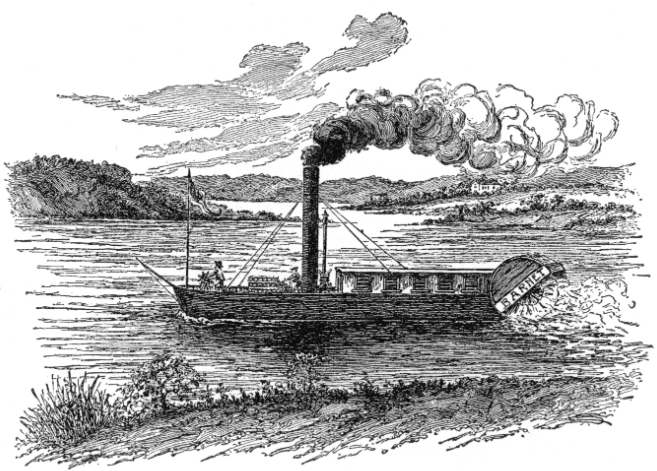Teacher’s Room Information
This room will help teachers develop inquiry-based activities that draw on local and national historical events. The Steamboat Barnet website lesson plans are aligned with the National History Standards (UCLA), Massachusetts History and Social Science Curriculum Frameworks, and the Common Core State Standards.
Investigations explore the revolutionary changes in transportation of the early 1800s that shaped the development of expanding market economies and an entrepreneurial spirit in cities and towns in the Connecticut River Valley.
Activities are designed to help students use the primary documents to analyze events in local history and relate them to events unfolding nationally.
Students will explore the site’s primary and secondary sources and integrate them to develop a nuanced, multi-faceted understanding of the evolution of the Connecticut River Valley.
Using Primary Sources in Grades 8-12
Recognizing Primary Sources
The primary documents and artifacts on this site will engage students in the hands-on research that will allow them to think like historians. Be sure students can:
Suggested Activities
- Have students analyze the primary sources on this site by asking them to:
- Recognize (and list) the differences between primary and secondary sources
- Identify the different types of primary sources (documents and artifacts)
- Demonstrate how each contributes to an deeper understanding of the past
- Integrate primary documents and artifacts to summarize their findings
- Work in pairs to read, discuss, and analyze the Lathrop Letters while examining the sketch of the Steamboat Barnet
- Compare their discoveries to the South Hadley Canal Traveler’s Account while examining the sketch of a flatboat
- Analyze and interpret the advertisements and the products produced in the Valley
- Explore maps and charts to evaluate the relationship between increased economic activity and population growth in Connecticut River Valley cities and towns
- Describe how the American System facilitated the economic transformation and entrepreneurial spirit of the Connecticut River Valley
- Summarize the insights they gained about the evolution of the Valley economy through primary and secondary sources
Using Background Material in Grades 8-12
Point out to students that in addition to examining primary sources, historians explore secondary sources so they understand the larger context of a historical event. Explain that the "Background" page serves as secondary source background information about the voyage of the Barnet. Teachers should read "Teachers Background Essay" for a more detailed, in-depth secondary source covering background information. Students should review the "Cast of Characters" for brief introductions to the unfamiliar historical figures they will encounter on the website. Encourage students to explore the websites and read one of the books (under Links and Literature).
Massachusetts History and Social Science Curriculum Frameworks
ECONOMIC GROWTH IN THE NORTH AND SOUTH, 1800-1860
USI.27 Explain the importance of the Transportation Revolution of the 19th century (the building of canals, roads, bridges, turnpikes, steamboats, and railroads), including the stimulus it provided to the growth of a market economy. (H, E)
USI.28 Explain the emergence and impact of the textile industry in New England and industrial growth generally throughout antebellum America. (H, E)
THE CIVIL WAR AND RECONSTRUCTION, 1860-1877
USI.35 Describe how the different economies and cultures of the North and South contributed to the growing importance of sectional politics in the early 19th century. (H)
Technologies that contributed to industrial growth
Causes and effects of the immigration from Northern Europe to the U.S. in the 1840s and 1850s
The rise of a business class of merchants and manufacturers
National History Standards
Standard 2A
The student understands how the factory system and the transportation and market revolutions shaped regional patterns of economic development.
Standards in Historical Thinking
Contents of Historical Thinking Standards for Grades 5-12
Explain how the major technological developments that revolutionized land and water transportation emerged and analyze how they transformed the economy, created international markets, and affected the environment.
Evaluate national and state policies on a protective tariff, a national bank, and federally funded internal improvements.
Explain how economic policies related to expansion, including northern dominance of locomotive transportation, served different regional interests and contributed to growing political and sectional differences.
Historical Thinking Standard 1: Chronological Thinking
Historical Thinking Standard 2: Historical Comprehension
Historical Thinking Standard 3: Historical Analysis and Interpretation
Historical Thinking Standard 4: Historical Research Capabilities
Historical Thinking Standard 5: Historical Issues-Analysis and Decision-Making
Common Core State Standards
Reading Standards for Literacy in History/Social Studies Grades 9-12
Writing Standards for Literacy in History/Social Studies Grades 9-12
Speaking and Listening 9-12
- Key Ideas and Details 1, 2, 3
- Craft and Structure 4, 5, 6
- Integration of Knowledge and Ideas 7, 8, 9
- Range of Reading and Level of Text Complexity 10
- Text Types and Purpose 1, 2
- Production and Distribution of Writing 4, 6
- Researching to Build and Present Knowledge 7, 8, 9
- Range of Writing 10
- Comprehension and Collaboration 1, 2, 3
- Presentation of Knowledge and Ideas 4, 5, 6



